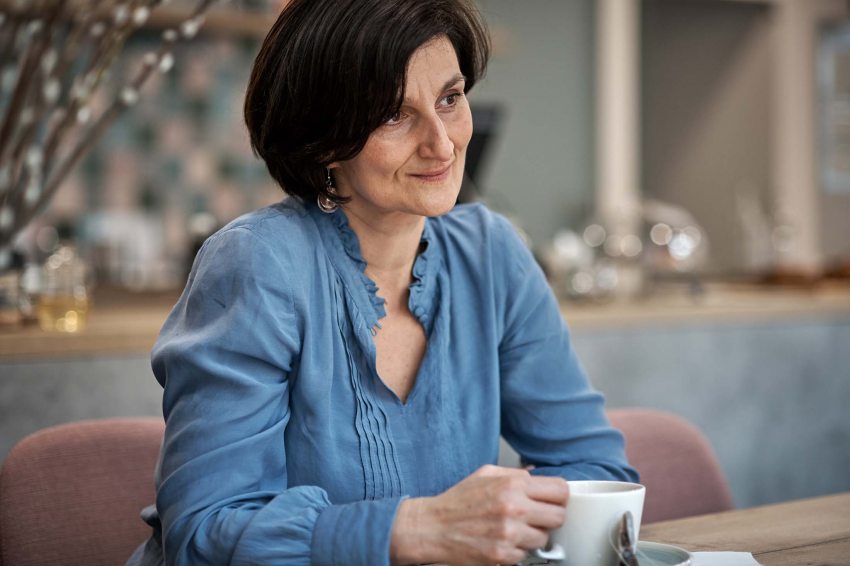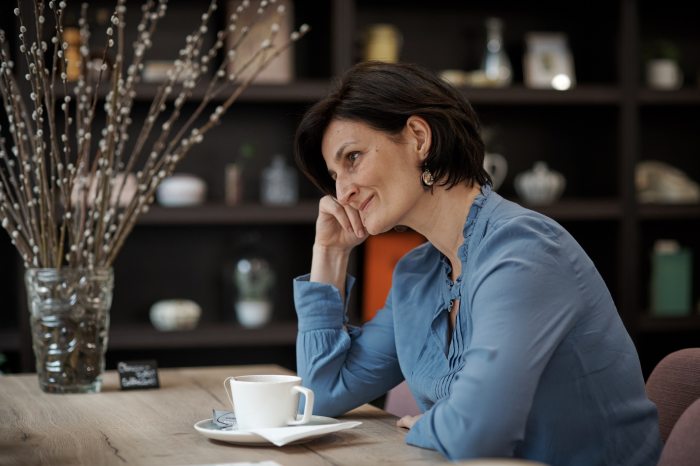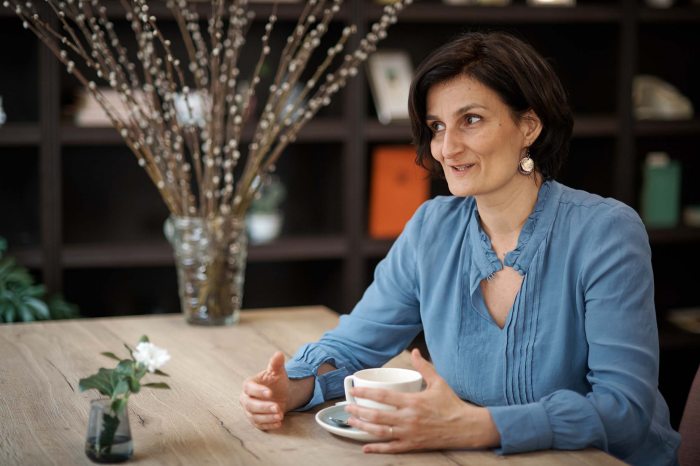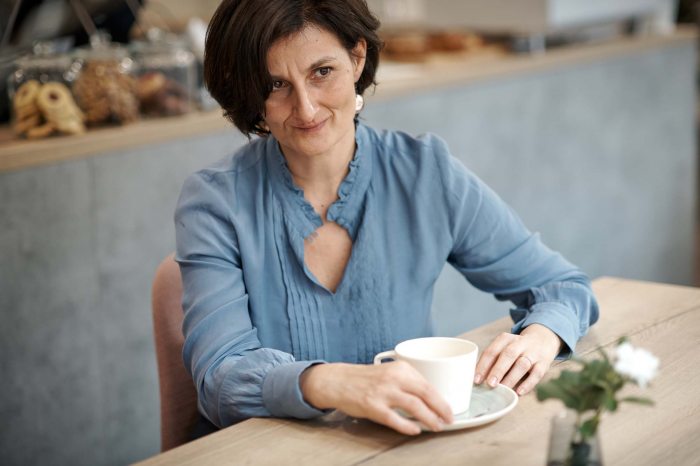Kati Szám: “It is impossible to untangle whether Képmás changed us or we changed Képmás”
For 15 years, Kati Szám has been editor in chief of the magazine Képmás, which through its unique content, refined style and traditional European system of values has already introduced several generations of readers to life principles and role models. For four years I have shared in the delights and difficulties of working in partnership with Kati yet when making this interview, I was still surprised by some of her hidden thoughts and traits.

In your book Családi karikatúrák (Family Caricatures) you compiled short stories about your own family, which were published in Képmás. These reveal that you make use of sarcastic humour to resolve conflicts or make them tolerable.
“Yes, that is typical of me, but I have also realized that you have to be careful with humour: each person’s sense of humour is different, so it can happen that what I intended as jolly badinage others might feel offended by. These days I am more careful with comments I intended to be light-hearted.”
Have your children read Family Caricatures that is about them?
“Of course. My older daughter even demanded to know why I had written that nobody at home wants to take the bin out. This was when I stopped these family stories because in their teens, the time of writing and the current time are too closely associated for them. It doesn’t bother them what I wrote when they were three years old, but at 13, that is a different story. Later on, my daughter did say I shouldn’t have given up because of this.” (laughs)
What qualities that have helped you in life did you inherent from your parents?
“My father became a doctor in line with the expectations of his family, but besides this he dug deep – as a self-taught person – into many different areas that he was truly interested in: history and languages; he learnt, for example, Finnish, and he managed to develop his understanding of Armenian to such fluency that he translated old texts and built up a dictionary. He learnt to read music and play the piano by himself. This kind of curiosity and interest, that cost him so much sacrifice, taught me, I think, never to be satisfied with good enough. I inherited a sanguine outlook from my mother, a mathematician and programmer; she always endeavoured to overcome difficulties with humour. She loved being the centre of attention and she always had an idea for everything; she endeared herself in the family and at work with constant surprises. And both wrote poetry, pretty good stuff, too. I haven’t tried that but I have inherited a love of literature and the desire to write.”
You got married in your twenties. What did your husband change and shape in you?
“I acquired a lot of self-confidence from him, or rather, from how he saw me.
“In a good relationship, we see ourselves as mirrored in the eyes of the person who truly loves us.
“He always believed in and trusted me. If he hadn’t encouraged me, I would never have applied to university after college, and I wouldn’t have gone to the school of journalism.”
How have your three children helped or hindered your development as a human being?
“The children are miracles! Once one bears responsibility for somebody, decisions become so much clearer because everything falls into its own order of importance. Thanks to my children I have been a part of so many things that otherwise would never have happened, and I have been able to benefit greatly from these experiences in my work as a journalist as well.”
Did you succeed in harmonizing the rearing of children with learning and earning a living? Wasn’t there ever a time when you had to make big compromises?
“After completing the Hungarian-history faculty at the teacher training college I taught as a teacher for six months, in the meantime I married and afterwards our first child was born. In the same month I applied to the humanities faculty at Pécs university where I graduated from the Hungarian department. I had to bring the state exam forward a little bit because this is when my second daughter was born. I started the journalism course after the birth of my son. The fact that I studied while being at home with the children, and then later wrote articles for journals as a freelancer, worked very well for me. When my children started going to school I looked for a permanent job and this is how I ended up at Képmás. In fact, I had already written for the magazine earlier while freelancing. Looking back on it, everything proceeded very smoothly.
“In general, I don’t express my wishes, most probably because of a fear of being disappointed, yet in retrospect I can say that all my unspoken desires were fulfilled.”
Didn’t you ever feel that you couldn’t bear the home-work duality?
“Of course I did! All the time. When I started working an eight-hour day again it was no longer a little refreshing intellectual pursuit like when I was freelancing. My conscience was permanently troubled by the feeling that perhaps I shouldn’t be where I was. One evening I had to stay in the editorial office until late and on the way home I waited quarter of an hour at the stop, there was a heatwave, the tram didn’t arrive, I felt I could hardly stand and there was a buzzing in my ears. I knew that I still had to wash the gym gear of one of the children for the following day, then I had to do shopping for the other because of a school excursion… An ambulance raced past me with its siren blaring and it crossed my mind: if I collapsed now and the ambulance took me away, how could things be arranged for the next day without me? And that is when I heard a voice in my head: ‘If I give a task, I give time for it as well.’
“Of course, I should have known by using my brain that if I believe in God, I also have to believe that I will live as long as I have work to do, but even so this sentence came to me out of the blue.
“I remember that I was profoundly calmed by this awareness and I had occasion to repeat this sentence later on as well. Now I can almost see in front of me the faces of certain readers: ‘Well, she’s hearing voices, she really believes that almighty God spoke to her!...” (laughs) But which is the greater temptation: to believe this, or not to believe?”
When you joined Képmás as an editor, it was still a parish-initiated fresh journal but with great, nationwide ambitions.
“It was founded in 2002 by father Mátyás Illéssy, who was parish priest of Solymár at the time. I joined as an editor only in 2003, and I have been editor in chief since 2005. Naturally, at the Komlósi Teaching Studio I didn’t learn anything whatsoever about what a magazine espousing Christian values is.
“I had to reconcile the professional standards and openness towards the world that I had learnt there with a definite set of values that I certainly did not want to overstep.
“Together with my co-editor Kati Zalka we resolved this apparent contradiction. Together we sought out this untrodden and narrow path. Képmás also moved along with our own search. Every single member of the then small editorial office desired, and worked for, a modern media product communicating values we considered important. By now it is impossible to untangle whether Képmás changed us or we changed Képmás.”
It feels good to pick up the magazine because it is as though it is the joint work of art of several people, and its design is a true aesthetic experience. It could have been a cultural magazine yet it didn’t develop in this direction.
“I don’t think it is the task of a magazine to serve the demands of a narrow segment with refined tastes but rather it has to reach a wider audience. If something doesn’t work, it embitters everybody’s life and a magazine can help on several levels to make the quality of life better: healthcare tips, psychological advice, including faith elements, good leisure programmes and quality literature. Let’s be slightly better people. Better parents, partners, friends, children. As far as I am concerned, this is the motto of our profession and life as a whole. As editor in chief, I believe that everything that helps this is a good topic. And as far as joint work goes, it is like a ‘stone soup’. The stone brings the ingredients together, a few important things are written on it, we can call it brand or professional, human creed, but the taste and the content of the soup is given by everything that is subsequently added by everybody. By those who believe in Képmás. Staff members and readers.”
The topic of most articles is related to the family. Why is family so much in the centre?
“The family is the foundation of all human communities. We are born into it, we are accepted in a good family, we accept and also we are in need of what we receive in the family. This is where we learn almost everything about human relationships, and our relatives help us as mirrors to better learn about ourselves. It is important what this environment is like.
“One not only has to tolerate the family like an uncomfortable armchair in the room, but it is possible and worth making it even more valuable.
“Media products can help enormously in this, at the level of prevention and preparation, with sensitization and giving good examples. An instructive story or a good sentence can spark a positive chain reaction in the soul.”
Is this why you and your colleagues founded the Media for the Family Prize, which honours journalists writing positively and constructively about the family?
“The expression ‘positively’ can be misleading, it does not only mean writing about good things, but it is done so as not to ruin family values. When the prize was founded, we frequently came across media features presenting the family in a destructive way: that divorce is fashionable, having children is an obstacle to development, and one has to flee from a relationship that is malfunctioning. On entering the search word ‘family’ in the browser, it sometimes happened that the first hit was about ‘violence within the family’.
“Reality sacrificed on the altar of readership and viewership shows sensation and scandal, and implies that this is standard. In order to counter this, we wanted to support those journalists capable of showing the protective, healing and positive side of the family.
“We set up the Media for the Family Foundation and the professional prize today worth HUF 1 million in order to encourage these articles. Right from the very beginning, we managed to get many excellent journalists and experts to join the jury, for example, Professor Mária Kopp, Dr. Petra Aczél and Ilona Keresztes, who are all still jury members.”
Were you deliberately trying to refute stereotypes, for example, that women’s attention cannot be occupied by serious topics, only fashion and household tips, that a magazine cannot be sold without light romantic and tabloid stories?
“Yes, but perhaps today this does not even need refuting. Moreover, since then we have also changed a bit. We now speak to both women and men because it is similarly prejudice if we say that ‘magazine topics’ are only of interest to women. After all, topics like how to stay healthy, how the environment can be protected for our children, how we can learn more about the world and how we can live in a better relationship are all of importance for men as well.”
What do you think of those criticisms that Képmás is not sufficiently aggressively public affairs-oriented and that it being addressed to ‘women and men’ is not trendy enough?
“Sometimes we deal with not exactly heart-warming yet still important topics. For example, with disadvantaged regions, sad social phenomena, fate and serious ethical issues. Although we would like to present the beauty of life, it is also the task of a good magazine to give those of us who are in a luckier position some insight into those difficulties we do not experience in our own personal life. We cannot stand aloof from these. Actually, the addressing can also be militant because it means that God created man and woman in His own image. We dare to state this as well. And this means that on the basis of a certain type of conservative feminism, we consider man and woman to be of equal status but not identical, and comprehended in their entirety only when together. I wouldn’t want to buy white wine with a red wine label.
“Nor do we sell anything other than what we advertise on the cover page: ‘Képmás, for women and men’.”
How and why did the Képmás evenings start? How did the two-person conversation grow into a synthesis of the arts evening attracting an audience of several hundred?
“The first staff member of Képmás, András Urbán, always wanted us to meet our readers in person and create a community. We held the first conversation in the grand hall of Szent Margit Grammar School after screening the opera film Bánk bán. This was followed by a successful series with celebrity presenters, but after a time it died out due to lack of interest. We relaunched this as themed evenings four or five years ago, purely from Képmás resources, generally I was the compere but sometimes my colleagues did their bit, you included. After 18 months, I felt that this conversation choreography was not sufficient for people to dedicate a weekday evening after work.
“Everybody wishes for catharsis, an artistic experience and entertainment. I had the idea of linking the talks with artistic productions, dance, music, literature, theatre and film.
“Not necessarily as the topic of conversation but in order to be inspired by it. A good magazine is not only a data supplier, a forum providing tips, but art should also have a place in it.”
When you are writing or editing the magazine, can you visualize the ideal reader?
“I think that while editing, I primarily visualize those people with whom I could have a good chat. However, when the magazine is published, I always try to look through it with the eyes of a ‘more critical outside observer’, I ponder on what a person very different to me would make of this or that article. If I did this when editing, it is possible that nothing would ever pass through the filter. (laughs) They normally put out Képmás at the Salesian Chapel I attend on Sunday. When entering, I genuflect and my gaze falls on the magazines and – it is unbelievable for me as well – it is as if all one hundred pages pass before my eyes. Can I stand in front of God with the content of these one hundred pages? Of course, it’s no bad thing if I quickly finish flicking through the pages because this is not what I came for, after all.”









